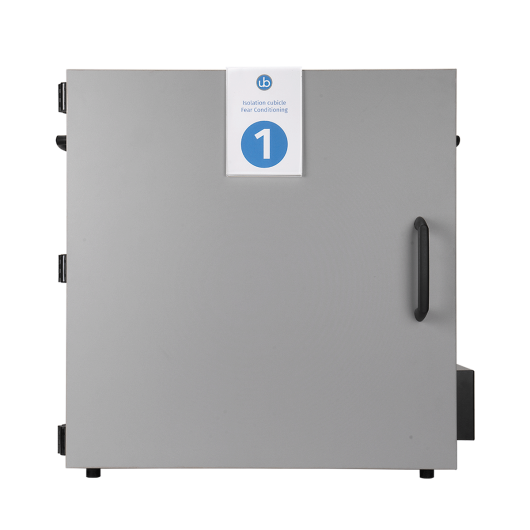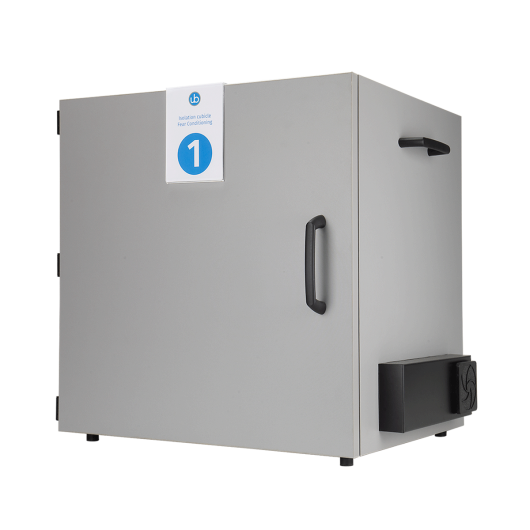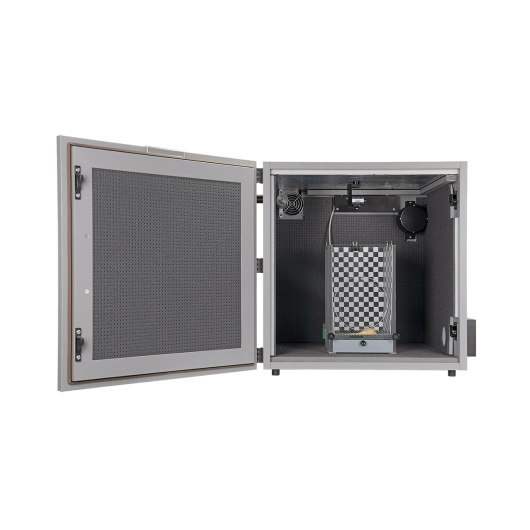




Fear conditioning system
Fear conditioning is one of the most common methods to measure memory in rodents. It exploits the Pavlovian association between an unpleasant unconditioned stimulus (shock) to a conditioned neutral stimulus (sound cue). The reaction of rodents, as predated animals, is to freeze (stay immobile) when exposed to fearful situations, such as a shock.
Once the association has happened and the animal has memorized it, freezing will happen also when the sound is presented without shock. This is the principle of Fear Conditioning, which is also coupled to the change of the change context (appearance) to ensure that the animal is reacting to the association to the sound and not to the environment (cued and contextual fear conditioning).
Background of fear conditioning experiments
- Fear conditioning is one of the most common methods to measure memory in rodents
- It exploits the Pavlovian association between an unpleasant unconditioned stimulus (shock) to a conditioned neutral stimulus (sound cue or context)
- The reaction of rodents, as predated animals, is to freeze (stay immobile) when exposed to fearful situations, such as a shock
- The ratio between the freezing with and without shock gives a measure of the memorization of the event and hence allows for a fast memory screening
Easy control, easy set up, easy expansion of Fear conditioning system
The Ugo Basile fear conditioning system comes complete with:
- Visible and IR lights
- Ventilated isolation cubicle
- Shocker and electrified cage
- High intensity speaker for frequency and white noise sounds
- IR camera, cables and lenses
- Color-coded easy connections with the onboard electronics
- Seamless to be expanded from 1 to 4 or more units for high throughput
- Detection of the Freezing is automated through Any-maze or any other software, as well as the control of lights, sounds, shocker, etc.
Features&benefits of Fear conditioning system from UGO Basile
- One USB cable connection: seamless installation and connection to PC
- Miniaturized USB-IR camera with 2 lenses (normal and fish-eye): camera mounted on the ceiling and working in any light conditioning and with any cage dimension
- Interchangeable contexts: easy to mount on the walls with different patterns
- IR and visible illumination: experiments can be run in light or darkness, also as a tool to alter the context
- Same software controls devices and analyses freezing: fast learning curve in building protocols and automatic detection of freezing
- Version for tethered animals: compatible with optogenetics and electrophysiology
- Multiple cage dimensions: most suitable dimension for rats or mice
- 46001 Fear conditioning unit
- 46000-596 Sound attenuating cubicle: inside dimensions wide 48.5 x deep 38.5 x hight 48.5 cm
- 46000-325 Dual visible/I.R. light
- 46000-165 Speaker
- 46000-105 Controller on-board
- 47400-035 USB camera
- Cables and power supply
- 60000 ANY-maze software
- 46001-2 Bundle of 2 Fear conditioning units
- 46001-3 Bundle of 3 Fear conditioning units
- 46001-4 Bundle of 4 Fear conditioning units
- 46002 Rat cage, inside dimensions 26 x 26 x height 30 cm
- 46002-D03 Mouse XL cage, inside dimensions 26 x 26 x height 30 cm, with mouse floor
- 46003 Mouse cage, inside dimensions 17 x 17 x height 25 cm
- 46003-D03 Mouse cage with front door
- 46004-D03 Mouse cage XL for fear conditioning
- 46005 Fear conditioning cage for observational learning
Amyloid precursor protein intracellular domain-dependent regulation of FOXO3a inhibits adult hippocampal neurogenesis, Neurobiology of aging
Mei Jiang et al., 2020
Temporal gene expression profile of the hippocampus following trace fear conditioning, Brain Research
Sirri et al., 2010
Prior Stress Promotes The Generalization Of Contextual Fear Memories: Involvement Of The Gabaergic Signaling Within The Basolateral Amygdala Complex, Progress in Neuro
CL Bender et al., 2018
Sex-And Estrus-Dependent Differences In Rat Basolateral Amygdala, J. Neurosc
SR Blume et al., 2017
Differential Brain, Cognitive and Motor Profiles Associated with Partial Trisomy. Modeling Down Syndrome in Mice, Behav. Genetics
PL Roubertoux et al, 2017
Strain Specific Effects of Low Level Lead Exposure on Associative Learning and Memory in Rats, NeuroToxicology
M. Verma & JS Schneider, 2017
| Product name | |
|---|---|
| 46001- 4 Fear conditioning with mouse cage (vertical, hinded front door) | |
| 46002 Fear conditioning with mouse cage | |
| 46003 Fear conditioning with rat cage | |
| 46004 Fear conditioning with mouse XL cage | |
| 46005 Fear conditioning cage for observational learning | |
| 46003-D03 Fear conditioning cage for tethered mice | |
| 46003-D03 Fear conditioning cage for tethered rats | |
| 46004-D03 Fear conditioning cage for tethered rats XL |





